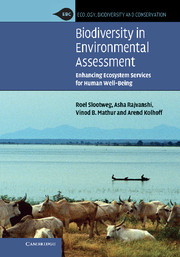Book contents
- Frontmatter
- Contents
- List of contributors
- Foreword
- Preface
- List of abbreviations
- Part I Setting the stage
- 1 Introduction
- 2 Interpretation of biodiversity
- 3 Biodiversity conservation and development: challenges for impact assessment
- Part II Assessment tools
- Part III Emerging issues
- Epilogue – Topics in need of further elaboration
- Annex: valuation of ecosystem services: influential cases
- References
- Index
1 - Introduction
Published online by Cambridge University Press: 05 July 2014
- Frontmatter
- Contents
- List of contributors
- Foreword
- Preface
- List of abbreviations
- Part I Setting the stage
- 1 Introduction
- 2 Interpretation of biodiversity
- 3 Biodiversity conservation and development: challenges for impact assessment
- Part II Assessment tools
- Part III Emerging issues
- Epilogue – Topics in need of further elaboration
- Annex: valuation of ecosystem services: influential cases
- References
- Index
Summary
Biodiversity matters to everyone. Its loss impoverishes the environment and reduces its capacity to support people now and in the future. Impact assessment can help to ensure that development is compatible with the conservation and sustainable use of biodiversity.
These are the opening words of the biodiversity in impact assessment principles formulated by the International Association for Impact Assessment (IAIA, 2005) and perfectly set the stage for a book that stresses the dependency of humanity on benefits from biodiversity, explores how present and future environmental securities are linked with biodiversity, and stimulates the need to balance the need for conservation with that for human development through sustainable use of biodiversity.
Through his simple quote in Closing Circle – ‘Everything is connected to everything else’, Barry Commoner (1971) conveyed the importance of interconnectedness between the different components of the living world. Human activities do not occur in a vacuum but are an inherent part of complex biological systems, such as food chains, and large-scale abiotic processes, such as the water cycle or climate change. This interconnectedness helps us to understand that most ecological systems are complex, making it difficult to come to a consensus on cause-and-effect relationships. If we are to develop truly sustainable economies and ensure the perpetuity of the ecosystem benefits that drive economies and human well-being, we must have a better grasp of the intricate relationship between the environment and the factors that bring about changes. Moreover, we must make sure that available knowledge is used in the best possible way to support day-to-day decision making on large human interventions.
- Type
- Chapter
- Information
- Biodiversity in Environmental AssessmentEnhancing Ecosystem Services for Human Well-Being, pp. 3 - 13Publisher: Cambridge University PressPrint publication year: 2009



